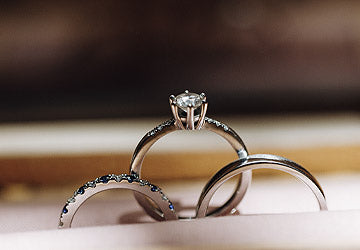That beautiful, sparkling, cut diamond you envy, might not be a real diamond. You might be surprised at how many “diamonds” you see in the jewelry store near you are lab-grown or simulant diamonds – like moissanite. But, what is moissanite, and what differentiates it from other simulated diamonds?
Learn everything you need to know about moissanite and how it is used to imitate real diamonds. Find out what makes a lab-grown gemstone different from a simulated diamond. And, discover what makes a diamond sparkle.
WHAT IS MOISSANITE?
After shopping for a wedding diamond at your local jewelry store, you may notice that many wedding stones are not diamonds. You likely came across the term, "moissanite.” So, you might be wondering, what is moissanite?
Moissanite has a very similar appearance to real diamonds, which makes them a great alternative. The material is made of silicon carbide which is crafted to imitate the same features as natural diamonds. Unlike a lab-grown diamond, moissanite and its numerous crystalline polymorphs are naturally occurring – so, moissanite is a diamond simulant.
WHAT IS A DIAMOND SIMULANT?
Simulated diamonds are manufactured to mimic the same visual characteristics of natural diamonds. Examples of simulant diamonds include moissanite, white topaz, and cubic zirconia. Though simulated diamonds embody the visual brilliance and other characteristics of real diamonds, their molecular and chemical properties are vastly different.
LAB DIAMONDS VS SIMULATED DIAMONDS
Lab diamonds – also called synthetic, lab-grown, cultured, engineered, or manufactured diamonds – are chemically indistinguishable from “real” diamonds. Lab diamonds grow in a controlled laboratory environment, instead of the Earth's mantle. Using advanced technological processes, lab-grown diamonds are subject to a highly-accelerated process that mimics natural geological conditions over a long time.
WHAT ARE REAL DIAMONDS?
If lab diamonds are structurally and optically identical to “real” diamonds – what is a “real” diamond? Engineered diamonds are real diamonds, but the difference lies in where the diamond comes from. The most expensive and rare type of diamond is earth-mined.
An earth-mined diamond is the only type of diamond to exist, until the 20th century. Simulant diamonds are the first alternative to appear. And, synthetic diamonds are a marvel of technology, as recently as 1955.
HOW EXPENSIVE IS MOISSANITE?
In terms of the price, simulated diamonds are the most affordable option – by far and away. Earth-mined diamonds carry the highest price-tag, and synthetic diamonds are priced somewhere in the middle. Simulated diamonds, however, are much further from synthetic diamonds on the price-scale, than the price of synthetic diamonds are to earth-mined diamonds.
Synthetic or lab-grown diamonds are rated on the same grading scale as earth-mined diamonds. Lab diamonds are graded on a scale that extends higher than that of earth-mined. Moissanite and other simulant diamonds are manufactured to feature the same geometric cuts as real diamonds. And, even though moissanite is naturally occurring, it is very rare in nature. So, the moissanite used in jewelry is often created through a manufacturing process.
This lends to simulant diamonds being much more affordable than synthetic diamonds. Simulated diamonds are the perfect alternative to real diamonds because of, either, budgetary restrictions, and they are better for regular use. You get all the aesthetic and glamour of wearing a beautiful diamond, without the risk associated with a real diamond.
CUSTOMIZE YOUR SIMULANT DIAMOND JEWELRY
Moissanite provides a low-liability alternative to wearing synthetic or earth-mined diamonds – and you’d have to be a jeweler to know the difference. Customize your piece of jewelry with a moissanite simulated diamond, today. And, share this with your friends to educate your community about what is moissanite.





